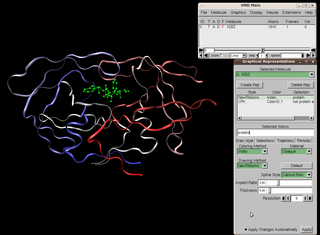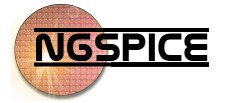
Visual Molecular Dynamics (VMD) is a molecular modelling and visualization computer program. VMD is developed mainly as a tool to view and analyze the results of molecular dynamics simulations. It also includes tools for working with volumetric data, sequence data, and arbitrary graphics objects. Molecular scenes can be exported to external rendering tools such as POV-Ray, RenderMan, Tachyon, Virtual Reality Modeling Language (VRML), and many others. Users can run their own Tcl and Python scripts within VMD as it includes embedded Tcl and Python interpreters. VMD runs on Unix, Apple Mac macOS, and Microsoft Windows. VMD is available to non-commercial users under a distribution-specific license which permits both use of the program and modification of its source code, at no charge.

Ngspice is an open-source mixed-level/mixed-signal electronic circuit simulator. It is a successor of the latest stable release of Berkeley SPICE, version 3f.5, which was released in 1993. A small group of maintainers and the user community contribute to the ngspice project by providing new features, enhancements and bug fixes.
SALOME is a multi-platform open source (LGPL-2.1-or-later) scientific computing environment, allowing the realization of industrial studies of physics simulations.
Tinker, previously stylized as TINKER, is a suite of computer software applications for molecular dynamics simulation. The codes provide a complete and general set of tools for molecular mechanics and molecular dynamics, with some special features for biomolecules. The core of the software is a modular set of callable routines which allow manipulating coordinates and evaluating potential energy and derivatives via straightforward means.
Specialized wind energy software applications aid in the development and operation of wind farms.
Web-based simulation (WBS) is the invocation of computer simulation services over the World Wide Web, specifically through a web browser. Increasingly, the web is being looked upon as an environment for providing modeling and simulation applications, and as such, is an emerging area of investigation within the simulation community.

AnyLogic is a multimethod simulation modeling tool developed by The AnyLogic Company. It supports agent-based, discrete event, and system dynamics simulation methodologies. AnyLogic is cross-platform simulation software that works on Windows, macOS and Linux. AnyLogic is used to simulate: markets and competition, healthcare, manufacturing, supply chains and logistics, retail, business processes, social and ecosystem dynamics, defense, project and asset management, pedestrian dynamics and road traffic, IT, and aerospace. It is considered to be among the major players in the simulation industry, especially within the domain of business processes is acknowledged to be a powerful tool.

Synopsys Simpleware ScanIP is a 3D image processing and model generation software program developed by Synopsys Inc. to visualise, analyse, quantify, segment and export 3D image data from magnetic resonance imaging (MRI), computed tomography (CT), microtomography and other modalities for computer-aided design (CAD), finite element analysis (FEA), computational fluid dynamics (CFD), and 3D printing. The software is used in the life sciences, materials science, nondestructive testing, reverse engineering and petrophysics.

SimulationX is a CAE software application running on Microsoft Windows for the physical simulation of technical systems. It is developed and sold by ESI Group.
QBlade is a public source, cross-platform simulation software for wind turbine blade design and aerodynamic simulation. It comes with a user-friendly graphical user interface (GUI) based on Qt.
JModelica.org is a commercial software platform based on the Modelica modeling language for modeling, simulating, optimizing and analyzing complex dynamic systems. The platform is maintained and developed by Modelon AB in collaboration with academic and industrial institutions, notably Lund University and the Lund Center for Control of Complex Systems (LCCC). The platform has been used in industrial projects with applications in robotics, vehicle systems, energy systems, CO2 separation and polyethylene production.
Simcenter Amesim is a commercial simulation software for the modeling and analysis of multi-domain systems. It is part of systems engineering domain and falls into the mechatronic engineering field.

Scott L. Delp is an American academic who is the James H. Clark Professor of Bioengineering and Mechanical Engineering at Stanford University. He is the Founding Chairman of the Department of Bioengineering at Stanford, the Director of the National Center for Simulation in Rehabilitation Research (NCSRR), Simbios, the NIH Center for Physics-Based Simulations of Biological Structures at Stanford., and the Mobilize Center, a data science research center focused on mobile health.
AnimatLab is an open-source neuromechanical simulation tool that allows authors to easily build and test biomechanical models and the neural networks that control them to produce behaviors. Users can construct neural models of varied level of details, 3D mechanical models of triangle meshes, and use muscles, motors, receptive fields, stretch sensors and other transducers to interface the two systems. Experiments can be run in which various stimuli are applied and data is recorded, making it a useful tool for computational neuroscience. The software can also be used to model biomimetic robotic systems.

SU2 is a suite of open-source software tools written in C++ for the numerical solution of partial differential equations (PDE) and performing PDE-constrained optimization. The primary applications are computational fluid dynamics and aerodynamic shape optimization, but has been extended to treat more general equations such as electrodynamics and chemically reacting flows. SU2 supports continuous and discrete adjoint for calculating the sensitivities/gradients of a scalar field.
Multibody simulation (MBS) is a method of numerical simulation in which multibody systems are composed of various rigid or elastic bodies. Connections between the bodies can be modeled with kinematic constraints or force elements. Unilateral constraints and Coulomb-friction can also be used to model frictional contacts between bodies. Multibody simulation is a useful tool for conducting motion analysis. It is often used during product development to evaluate characteristics of comfort, safety, and performance. For example, multibody simulation has been widely used since the 1990s as a component of automotive suspension design. It can also be used to study issues of biomechanics, with applications including sports medicine, osteopathy, and human-machine interaction.
Tendon-driven robots (TDR) are robots whose limbs mimic biological musculoskeletal systems. They use plastic straps to mimic muscles and tendons. Such robots are claimed to move in a "more natural" way than traditional robots that use rigid metal or plastic limbs controlled by geared actuators. TDRs can also help understand how biomechanics relates to embodied intelligence and cognition.







